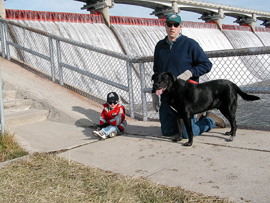2 Finding Ideas
Every person has a story to tell
“Ideas are like rabbits. You get a couple and learn how to handle them, and pretty soon you have a dozen.”
John Steinbeck
Finding feature ideas seems to be the most challenging job for most of my students. Every semester, they come back from their first pursuit of a story and tell me there is nothing to write about.
The truth is everything looks ordinary unless you see it through fresh eyes and think it extraordinary. Story ideas are truly on every corner, in virtually every person you meet, in your own interests and experiences.
So where should you start looking for story ideas?
- Listen to what people are talking about. Keep your ears open at work, parties, the park and the supermarket. Check out social media. The people you know are filled with story ideas.
- What interests you or what experiences have you had? Many publications do not share the same conflict-of-interest issues as a newspaper, so your own life experiences can make good story fodder.
- What is happening in the news or in research? Sexual assaults on college campuses, or the challenges related to student loans are two big national stories that could be tailored to a specific genre of publication — finance, parenting, etc.
- Who have you met? When you meet someone new and ask about what they do, really listen to the answers. You never know when someone might make a great profile.

“Ideas come from every aspect of my life,” Mike Wagner of The Dispatch said. “My personal life, in my job at the paper, reading other newspapers, having conversations with people at fundraisers where my wife works. Going to a football game and seeing people having little ceremonies over the bricks at Ohio Stadium that led to a 4,000-word feature story about what those bricks represent. We wrote those stories about the people behind those bricks. There are like 10,000 of them that people buy around the stadium up there.”
Wagner said he has covered everything from jump-rope competitions to princess parties, to a humanitarian who dedicated his life to helping poor people grow gardens and food on the west side of Columbus, which required a call to his widow two days after his death.
He also has profiled former heavyweight boxing champion Buster Douglas, who now works teaching boxing at Columbus Recreation and Parks, and one-time Ohio State quarterback Art Schlichter, who has been imprisoned multiple times after gambling derailed his life.
Where do those ideas come from?
“I made a list of people that I thought were interesting people in Columbus that we haven’t really done anything in-depth on,” he said. “Sometimes these stories take years to get, sometimes they take days and sometimes they take months. I started writing Art Schlichter in prison when I was a reporter in Dayton. I was actually at the Blue Jackets [NHL] game where a little girl was hit in the head with a puck and eight years later I contacted the family on the anniversary and Espen Knutsen, the guy who struck the puck, and it led to one of the most powerful feature stories I ever did. Then six months later it led to a reunion between the player and the family. So that was just born out of something that I was involved in personally.”
Sometimes those ideas lead to broader, more impactful stories.
Wagner recalls reading his newspaper a few years ago and seeing a blurb about a guy who jumped from an 11-story building in downtown Columbus. The paper had never done a piece of substance on suicide, but that incident created the spark of an idea.
“We went back and wrote a narrative story on who he was and how this happened and so on, and that ended up leading years later to a major project on suicides,” he said.
Many times, story ideas will pop into your head fully formed because of an experience you have, a person you meet or a publication you read.
Some examples:
- A new children’s store opens where you live and, while shopping, you learn a percentage of the proceeds go to support pediatric cancer because the owner’s son had leukemia.
- You notice an influx of electric cars in your neighborhood, and you start looking at the prevalence of such cars and how owners may feel about them.
- You start wondering about family vacation spots within a certain geographic distance (let’s say three hours) around certain holiday times (let’s say Christmas).
- You read an article about nationwide statistics on the increase in home-schooling and wonder how many people do it in your area and what challenges they may face.
- Your dog dies.

Believe it or not, when my dog, Cody, died in 2004, I turned it into a publication story because of my own feelings of loss and confusion.
After he had been euthanized, I honestly did not know what to do next with his body; do I bury him, cremate? Does such a service exist?
After researching the options (and selecting cremation), I figured others might be as lost as I was, so I pitched a story, and it was published under the simple but direct headline, “When Pets Die.”
So you see, story ideas are truly everywhere. The challenge is to extract them from your surroundings, distill them from ideas into solid story themes and find a place that would potentially want to publish them.
One of the hardest realizations of every young writer is that every idea you see or create is not always worth bringing to life. The greatest ideas in the world don’t mean anything if you are not able to execute it or there is not a publication willing to publish it.
“There has to be some kind of captivating, newsy element even in a feature,” Crane said. “I can’t think of a feature that I have read that didn’t have that.”
She recalled a favorite two-day feature series she wrote while a reporter for The Dispatch on a little girl who had brain cancer. She did not pitch her story saying, “I want to write about a kid with brain cancer.” Instead, she saw a new camp opening up for kids who are sick that allowed them to play and relax and be among other children who don’t ask them a million questions about their illness.
“If they go to another camp, they are going to be the sick kid who maybe gets pulled aside for medicine or maybe have a bald head or whatever,” she said. “We could have done a feature on the camp and all of its cool facilities or the nice people who are running it, but instead we decided to tell the story of the camp in a way through the story of one of the first campers. So we found this family who was participating in the first round of camping and the story ended up being about her and her family, but it started with this camp.
“It is really important to think about things that are newsworthy with a feature lens. This thing is happening but how could I tell it in a way that involves more storytelling and it maybe will be a richer reader experience than here is the day the thing opens, this is how much it costs, this is how many kids are going a year.
“What is the real meaning of this camp? The real meaning is that mom and dad are going to get a little bit of breathing room. The kid is just going to get to be a kid for a week. This is making our community a better place, so there are themes there.”
Some thoughts to consider as you develop a story idea:
- What is the focus
There is a big difference between a vague topic and an actual, potential story and you have to answer a few questions before you can focus and pitch it to an editor.
“You never just walk into your editor’s office or your instructor or your editor and just say, ‘I want to do a story on suicide, or I want to do a story on firefighters.’” Wagner said. “Your proposal should be at most a half a page, but you should be able to sum it up in three or four sentences with what you are wanting to write about, who you are wanting to write about and what impact the story may potentially have, and what makes them interesting.
“If the student can’t summarize that, then maybe it is not worth the time or they need to go back and do more research.”
Some elements to include in that pitch:
- Who is the audience for which you wish to write?
- What publication serves that audience?
- What exactly do you want that reader to know?
Localizing the Story of Barbaro
In 2006, when Kentucky Derby winner Barbaro broke his leg in the Preakness Stakes, his struggle for survival made him a media darling. Standing right alongside him was Dr. Dean Richardson, the surgeon who saved his life, who I had known years earlier when he had performed an emergency procedure on my own horse (who, thankfully, survived).

While nearly every newspaper and countless publications were writing stories on Barbaro and Richardson, I was anxious to find an angle I could pursue, considering my already-established connection with Richardson.
A little research revealed he was a graduate of Ohio State University — and had recently been named a Distinguished Alumnus from the College of Veterinary Medicine. I knew I had my angle.
I immediately contacted the Ohio State Alumni Publication with the “theme” that the most famous vet in America was a Buckeye, and how his experiences at Ohio State had helped get him where he is today.
Even though the editor was interested, she wanted the piece refined even more, so we had to wait a few months until the issue was “resolved” — which unfortunately meant Barbaro’s death.
But that was not the only place the article was published.
Columbus Monthly also contacted me about a piece on Richardson, and the articles actually came out within weeks of each other.
Although the markets were a bit overlapping, the story was big enough to warrant coverage in both — and I was lucky to have the connection to Richardson.
It was the same subject that had been covered by literally hundreds of other writers, but understanding the subject and potential publication markets helped make it a publishable story for me.
- Do you have the sources?
Just as important is your ability to access the sources you need to complete a story.
We’d all love to interview George Clooney or LeBron James, but access is unlikely.
You not only need to ensure you can reach a subject, but also that the source is willing to speak and has the information you need.
Take the story of a musician who owned a popular coffee roaster/cafe and also was in a band rising up the charts. Our kids had gone to pre-school together and we were good friends. I pitched the story, sure I had access, and was thrilled to call and tell him a publication was interested.
His response: “I’m not interested.”
He simply did not want the publicity for himself if it did not include his band.
- Are you the right author?
Your class on international terrorism might have been fascinating, and you might be an avid reader of Time magazine, but that does not make you an expert on Hamas’ impact on the West Bank or whether the Syrian conflict can be resolved through diplomacy.
To write on those topics requires significant understanding and respect in the field. If you have it, pursue those stories. If you don’t, let’s aim for the areas where our skill and experience do stand out. Let’s consider:
- Your neighbor turns her front yard into a vegetable patch. It could be a profile on her or a story on urban farming.
- Your dog is allergic to chicken. What other allergies do pet owners cope with and how?
- You read a newspaper story about a guy who had cancer and wrote a children’s book about it. The news might be the publication of the book. You could profile him to get the story behind the story.

Sometimes the feature value might appear evident but is not as fully fleshed out as it needs to be. Alison Lukan of The Athletic uses her professional colleagues to determine whether a story idea has potential, and advocates students doing the same.
“I can say, ‘Hey, I am thinking of working on a story about this. What do you think?’” Lukan said. “Sometimes, honestly, there is a joke among us, because I had an idea for a story and one of my colleagues said it was not good enough for a story, and it turned into one of our more popular stories. So sometimes don’t just blindly follow what people say.”
Publication or Article First?
Thankfully for us, publications need articles and someone to write them. The key is to pitch the right idea to the right publication and help them see why you are the ideal person to be the writer.
Pitches often come from two different trains of thought:
- I have a great idea, so I will seek a publication that will publish it, or;
- This publication is terrific and I want to write for it, so I will develop a story idea for it.
It really does not matter which one motivates you toward a story pitch. What is crucial is that the story idea you develop and the publication you pitch are a perfect marriage.
We have already discussed the need to read, but almost as important is to develop expertise in the story idea before you ever report or write a word.
You might think you know what your story is about, but can you do what is known as the “elevator pitch,” where you thoroughly explain it to someone in the 20 seconds it takes to ride up or down in an elevator?
What exactly do you want readers to know when they read your article? Is it original enough so that it has not been done before? Is it narrow enough to appeal to a specific audience? Have you identified the sources you will need and, just as importantly, are they accessible to you in the time frame you need?
“I try to have a decent idea as far as what my audience cares about, what my audience is interested in,” said Adam Jardy of The Dispatch. “A lot of times that will sort of steer me in one direction or another. But at the end of the day if you’re writing something that’s going to have a lot of heft to it, it’s got to be something that anybody would find interesting, something that you know you don’t just have to be a sports fan to appreciate, you don’t have to just be interested in that specific topic. You want to find something that speaks to a wide section of the population.
“It has to have enough of a hook to it, it has to have enough interest that they’re going to want to sit down and read the whole thing. You have got to identify that before you really start diving in and putting in all the time. If you don’t find it interesting your readers aren’t going to find it interesting, and then you’ve just wasted your time so you have to make sure you find it interesting and that you know that your readers will.”
So-What Factor
Every time a reader begins a story, he or she almost immediately begins to ask, “So what? What is in this for me?” That means writers have to anticipate that question and show the reader from the very first sentence why they should keep reading. In journalism terms, we call this the “so-what factor,” and we have to make sure every article contains it.
